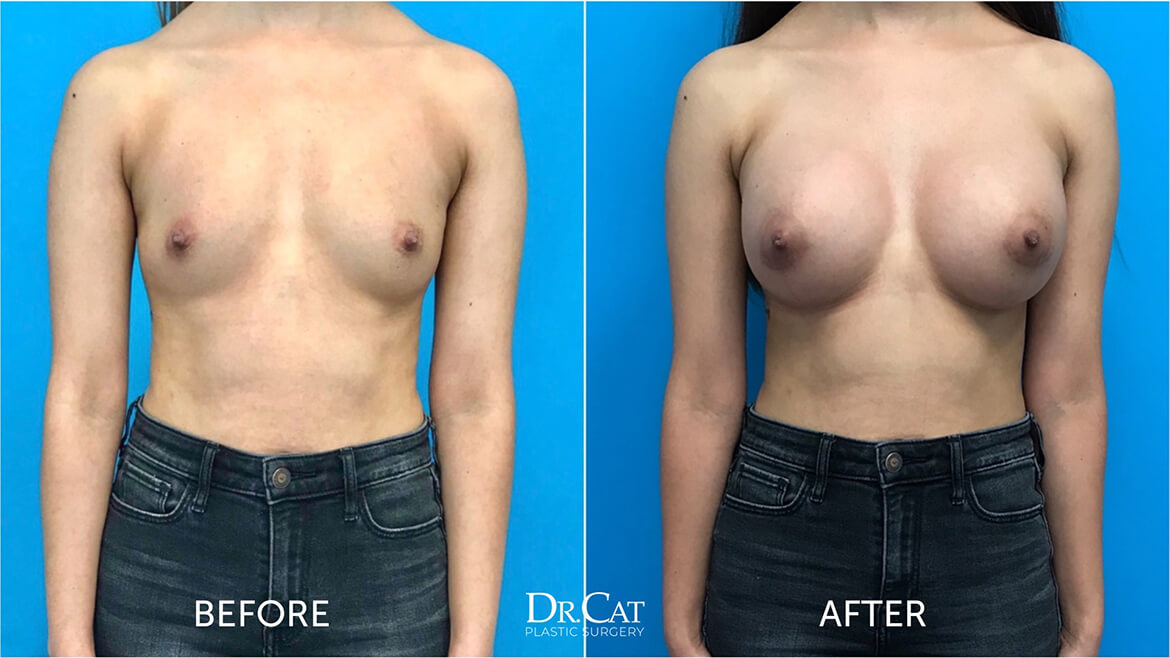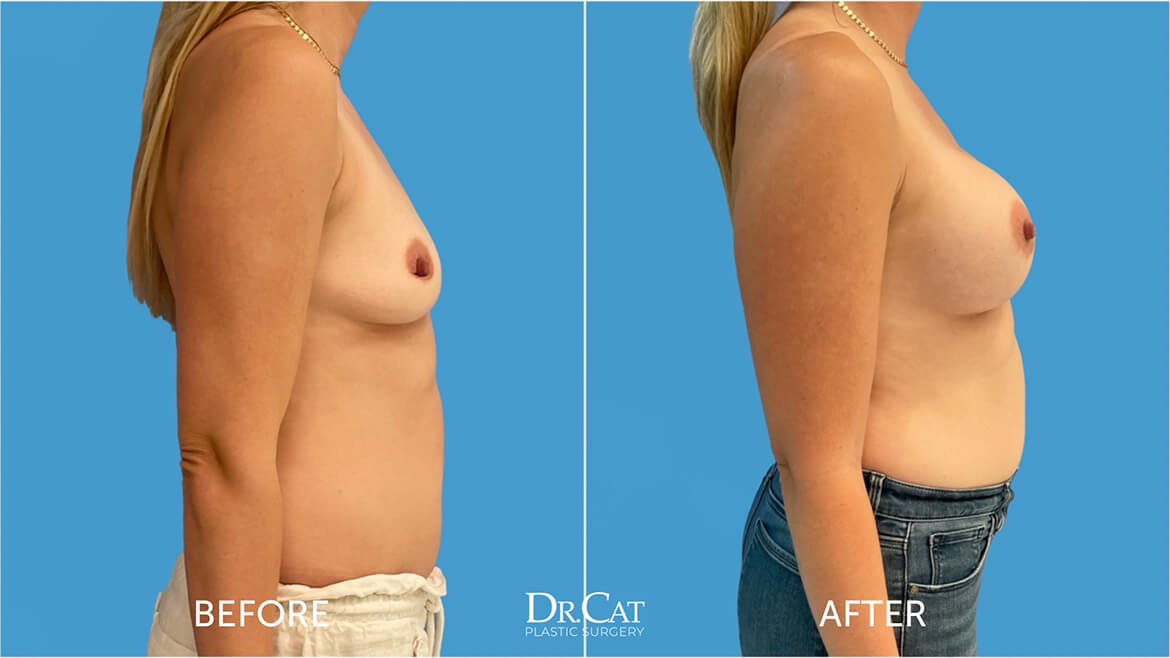Why Have Breast Augmentation?
If you’re reading this chances are you’re interested in getting breast augmentation. Every person chooses to have breast augmentation surgery for their own personal reasons. They may wish to enhance the size and shape of their breasts, make them more symmetrical, give them a lifted appearance or improve their overall body proportions.
Whatever your own reasons may be, you probably have questions. What does surgical breast augmentation entail? What is recovery like? How long does it take? Does it hurt? Basically what to expect every step of the way.
This article will provide you with useful facts and information, plus answer the most common questions about this popular surgical procedure.
How Long Does Breast Augmentation Take?
Are you wondering how long is a breast augmentation surgery? This procedure takes about three to four hours. Of course each surgery is unique and the duration can depend on several factors.
The amount of time your breast augmentation takes can be influenced by the following: type of breast implants, your surgeon’s technique, and whether it’s a primary or revision surgery.
Types of Breast Implants

Cohesive Silicone Gel: Both the outer pouch and filler material are made of silicone. Patients and surgeons agree that silicone gel implants have a more realistic look and feel.
Saline (Salt Water Solution): Women who may be worried about their breast implants rupturing may choose this option. A silicone pouch is placed in position then filled with saline.
Autologous Fat Transfer: This is the most natural option available today. Your own fat is harvested from a donor site and injected into your breasts to enhance their size and shape. The biggest drawback to fat is longevity, symmetry and size limitation.
Dr. Cat is an expert at performing breast augmentation using a patient’s own fat. Her unique technique ensures more fat cells survive for longer-lasting and symmetrical results.
Technique: Where are the implants placed?
Submuscular: The implants are inserted under the pectoralis chest muscles. This makes mammography easier and outcomes tend to be better for women who choose larger implants.
Subglandular: Placement is behind the breast tissue. This method offers women with laxity in their breast a more natural-looking implant.
The location of the incisions can vary as well.
Inframammary fold: The most common is under the breast at the crease. It has the least amount of impact on breastfeeding and the incisions are easily concealed for medium or larger implants.
Trans-axillary: The incisions are made at the armpits. This benefits women without a crease as it leaves no obvious scar under the breasts.
Peri-aeriolar: The incisions are made around the nipples. It’s ideal for smaller breasts but carries slightly more risk of nerve damage around the nipples.
Type of Surgery: Primary or Revision Breast Augmentation
If it’s your first time getting breast augmentation, it’s considered your primary surgery and should last about three to four hours. Any subsequent surgeries to correct issues with your first is called revision breast augmentation.
Revision surgeries can take longer as there may be scar tissue and other conditions that need to be addressed. Dr. Cat regularly treats breast augmentation revision patients in her practice. Her meticulous technique and attention to detail gives her patients results that are often better and more aesthetically pleasing than their previous procedures.
What to Expect After Breast Augmentation

Before surgery: A favorable result begins long before you ever step into the operating room. Choosing the right implant is crucial to how happy you will be with your breast enhancement surgery.
During the initial consultation process, Dr. Cat will show you breast augmentation before and after photos so you can visualize how your own new breasts will look after the procedure.
She will also have you try on a special bra with implants to help you determine the right size, shape and material. You will go through two sizing exercises to make sure the right implant is chosen for your body type and desired outcome.
Day of the Procedure: You’ll be asked to shower the night before and to not eat or drink anything at least eight hours before your procedure.
Your surgeon will mark the surgical areas with a white pencil and you’ll be brought into the operating room. Once you are made comfortable and warm on the operating table, your anesthesiologist will hook you up to an IV line that administers both fluids and your anesthesia.
You’ll slowly and gently drift off to sleep and awaken shortly after. It may only seem like you were asleep for a few seconds but a couple of hours have already passed. You will be kept under observation in the recovery room.
Your surgeon will check in with you to see how you’re feeling and a nurse will be on hand at all times to make sure your immediate recovery is going smoothly. After 1-2 hours you’ll be cleared to go home.
Make sure someone is available to pick you up after surgery. For your own safety, driving yourself home, taking a taxi or having a rideshare car pick you up is not allowed since you will still be wearing off of the anesthesia medication.
What to Expect After Breast Augmentation Recovery: When you arrive home you may still be sleepy from the medication given to you earlier. For this reason we recommend having someone with you for the first 24 hours.
You’ll be prescribed pain medication to get you through the first couple of days. After that, you can take over-the-counter pain medication such as Tylenol or Advil as necessary. Once you have stopped taking your prescription medication, you can drive and run errands if necessary. You can even go back to work after 2-3 days.
You will wake up from anesthesia wearing a compression garment. You will need to continue wearing it for six weeks. This is very important otherwise your new implants can potentially dislocate from their correct placement. Also, check your incisions regularly for any signs of infection. If you notice excessive redness, swelling or pain, notify your surgeon immediately.
While wearing the compression garments, you’ll also want to avoid engaging in strenuous exercise such as cardio and heavy lifting. After six weeks, once the garments come off, and your surgeon clears you, you’ll be able to start exercising again.
How Long Do Breast Implants Last?

Breast implants are not permanent. You can choose to remove them at anytime or replace them with a new pair. In fact, the FDA recommends replacing breast implants every ten years for health and safety reasons. Check out this BLOG for five things to know prior to getting breast implants.
Why do you need to replace breast implants? Even the best implants don’t last forever. The outer shell can potentially crack or break. Today’s implants are safer than they’ve ever been; however, studies show that silicone materials start to degrade after about ten years, then it’s time to replace them.
Here’s how to know if your implants need replacing: one or both of your breasts may feel hard, you may feel calcified lumps around the implant, or you detected a rupture. All these conditions will need to be addressed by your surgeon.
Dr. Cat performs breast explant (removal) surgery regularly and is highly skilled and experienced in this type of procedure.
For more information about our services, breast augmentation before and after pictures or general questions give us a call at 310-858-8808. You can also reach us by email at [email protected]. Use this link to book a pre-consultation phone call: https://beautybydrcat.com/book-consultation.

